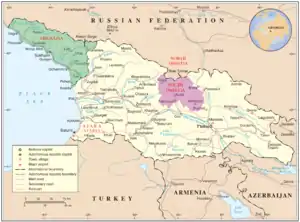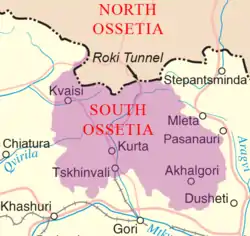Roki Tunnel
The Roki Tunnel (also called Roksky Tunnel, Georgian: როკის გვირაბი; Ossetic: Ручъы тъунел; Russian: Рокский туннель) is a mountain tunnel of the Transkam road through the Greater Caucasus Mountains, north of the village Upper Roka. It is the only road joining North Ossetia–Alania in Russia into South Ossetia, a breakaway republic of Georgia. The road is manned at the town of Nizhny Zaramag in North Ossetia and is sometimes referred to as the Roki-Nizhny Zaramag border crossing.


The tunnel, completed by the Soviet government in 1984, is one of only a handful of routes that cross the North Caucasus Range. It is at about 2,000 metres (6,600 ft) altitude and its length is 3,730 metres (12,240 ft), and near the Roki Pass at about 3,000 metres (9,800 ft) altitude, which can only be used in summer.[1][2] The other routes between Georgia and Russia include the Kazbegi–Verkhni Lars customs checkpoint on the Georgian Military Road, closed June 2006 [3] and reopened 2010, and the Gantiadi–Adler crossing in Abkhazia which Georgia asserts functions illegally.[4]
The tunnel has been important throughout the Georgian–Ossetian conflict. The South Ossetian authorities use tolls levied on tunnel traffic as one of their main sources of revenue. The Georgian government, backed by the United States, has long called for the South Ossetian side of the tunnel to be placed under the control of international monitors, rather than by the South Ossetian secessionists and their Russian allies.[5] When the Russian authorities blocked the Kazbegi-Verkhni Lars customs checkpoint between June 2006 and March 2010, the Roki Tunnel was the only available road route from Russia to South Ossetia. The tunnel was also used as a supply route for the Russian troops during the 2008 South Ossetia War.[6]
The tunnel was reconstructed due to damage caused by 2008 South Ossetia War.[7] Reconstruction took two and half years and was finished in October 2015.[8] All costs of reconstruction were paid by the Russian side.
References
- "Der Roki-Tunnel – Schlüsselstelle im Georgien-Konflikt" (in German). Derstandard.at. 2008-08-18. Archived from the original on 2016-03-16. Retrieved 2019-02-03.
- "Roki Tunnel". Structurae.de. Archived from the original on 2015-12-26. Retrieved 2008-08-10.
- "Families split by Ossetia border closure". 2008-01-23. Archived from the original on 2008-09-08. Retrieved 2008-08-10.
- "Explosion Redirected". 2006-07-10. Archived from the original on 2006-07-15. Retrieved 2008-08-10.
- "Georgian rebel region evacuates children after deadly clashes". Channel NewsAsia. 2008-08-05. Archived from the original on 2008-09-11. Retrieved 2008-08-10.
- Michael Evans (2008-08-11). "Georgia: Reckless Saakashvili took on Russian Goliath Putin". The Times. Archived from the original on 2008-09-03. Retrieved 2008-08-11.
- "Roki tunnel reopened". DFwatch - Democracy & Freedom Watch. 2014-11-10. Archived from the original on 2015-12-08. Retrieved 2016-08-29.
- "Second phase of the Roki Tunnel Construction Completed at the Border with South Ossetia". SK Most. 2014-10-21. Archived from the original on 2016-09-18. Retrieved 2016-08-29.
External links
- "Roki - Tunnel of Misfortune". The Georgian Times. 2008-09-04. Archived from the original on September 4, 2008. Retrieved Sep 10, 2008.